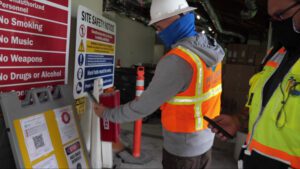At the beginning of the pandemic, the construction industry quickly realized that face-to-face health screenings and paper record keeping was not the most efficient process. Besides being time consuming and increasing the potential for transmission of COVID-19, it created a significant amount of paperwork that needed to be managed, organized and physically stored. The paperwork was filed in a cabinet or entered into an online database. In either scenario, it was rife with problems including illegible handwriting, erroneous data entry, and an inability to determine where exactly a worker or visitor was located for efficient and reliable contact tracing. This increased the risk of a jobsite shut-down due to an outbreak.

Digital Check In Lower Jobsite Risks
All of those issues led to the rise in digital check-in apps. They offer an easy and private way for a worker using a smartphone and QR codes to check-in and out of a jobsite. Workers simply point their smartphone at the QR-coded poster on site to log in. From there, they answer health screening questions and based on their responses, are admitted to the job site. The digital records make it easy to keep track of who was onsite and when, making private check in and contact tracing possible for the GC. However, it’s the GC’s responsibility to ensure that the safety and security of check-in data and record keeping are in accordance with compliance regulations, including HIPAA.
As digital check-ins have become part of the daily routine, many GCs tout their long-term benefits, especially in reducing the following three risks.
- Not knowing the subcontractor or material supplier’s employees on the project, the area they’re working in, and where they are at any given moment.
- The time workers, subcontractors, and visitors arrive and leave.
- An inability for a worker to verify they have reviewed safety and compliance requirements.
Without this information, a GC increases the risk of insurance claims, lawsuits and fines. For example, an accident on a job site requires detailed information such as the time and date of the accident/event; name and job title of the person reporting the accident; name of person to contact at accident/event site; name and address of injured employee(s); nature of injuries; location where injured employee(s) was/were taken for medical treatment; list and identity of other law enforcement agencies present at the accident/event site; description of accident/event and whether the accident scene or instrumentality has been altered.
Digital Record Keeping for Compliance and Regulation
The information gained from digital check-in apps is critical in providing accurate information to OSHA investigators and insurance companies. It also provides necessary information to company management to prevent future similar accidents.
For a majority of GCs, irregularities in billing-to-hours worked by subcontractors can expose the employer to prevailing wage fines. Thus, it’s important to reconcile payments and contracts based on the number of workers onsite, amount of hours worked, and amount of work completed. Check-in data proving job site attendance by the worker can also mitigate the risk of unpaid wage claims by workers and subcontractors.
Also, consider a GC that mandates a worker watch a safety video before they start their shift. Through a digital check in, the video can be presented and the GC can see if it was viewed. They could also add follow up questions to confirm the worker understood the video. Otherwise, the worker would not be allowed to enter the job site.
Another driving factor in digital check-ins is the return to the office, in its many forms as hybrid work models are popular among knowledge workers in traditional offices. As employees and vendors acclimate to the new normal at work, the need for digital check-ins is heightened. It reinforces security, helps manage capacity, and provides a way to easily do contact tracing for any virus. It also provides a way to offer private vaccination verification.
How Check In Data Saves Money
When it comes to reviewing project costs, a closer look at digital check-in data and analytics can be enlightening.
Since many project managers are usually assigned multiple projects, being able to look at their phone and see who checked-in and at what time can be more efficient than driving from site to site to check on attendance and project status.
Finally, being able to identify staffing or labor issues earlier provides an opportunity to intervene before there are delays to the project. Looking at weekly, monthly or project productivity reports by employee or subcontractor offers insight that can be applied to future hiring, raises, and bids.
GC’s have a fundamental need to know the who, what, where, and when of job attendees. To mitigate risks and maximize profitability, GCs need to take a close look at how they manage their entry and exit protocols for workers, subcontractors and visitors.

David Brian Ward is a CEO and Founder of Safe Site Check In LLC, a digital jobsite management platform launched in 2020 for the Construction industry. With over 40 years of experience in the technology industry, having launched and grown several successful companies. Mr. Ward is a now a SaaS entrepreneur and innovation leader in the Construction industry.

